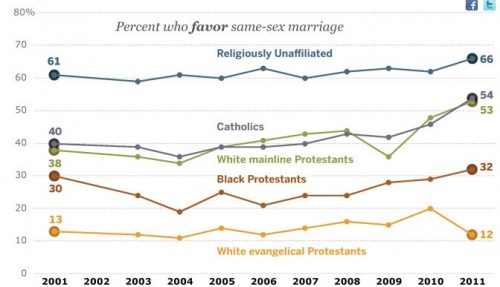In response to my post yesterday about tourism ads presenting local (often, though not always, non-White) residents of vacation hotspots as tourist attractions and amenities for relatively privileged travelers to enjoy, Lauren J. sent in a Heineken ad that pokes fun at the expectations visitors to Jamaica often have about how Jamaicans would act, and how local residents may feel obliged to play along and give tourists (with their cash) the “authentic” experience they desire:
Archive: 2011
In the contemporary Western world, naked and near-naked bodies are revealed everywhere. But most of the bodies we see are those of models and actors, carefully cultivated, chosen, and digitally altered to look a particular way. Except, artist Clarity Haynes notes, the “before” pictures in advertisements for diet plans and cosmetic surgeries. She writes:
“Before” pictures pop up constantly on our computers and in magazines, as part of the daily landscape of imagery. These “before” pictures, meant to shock and scare, show bodies that are presented as needing urgent correction and control, through weight loss or plastic surgery.
In an effort to reclaim these “before” bodies, Haynes has lovingly painted a range of female bodies. The Breast Portrait Project, she continues:
…is about finding dignity and beauty in the physical characteristics of the body that our popular culture often ridicules and heaps with shame, and in the process allowing the models who participate to feel pride in their particular selves — and by extension, the viewers of the work as well, regardless of their gender.
Visit Hayne’s gallery. And, for more normalizing of normal bodies, see these selections of breasts, bellies, and vulvas.
Lisa Wade, PhD is an Associate Professor at Tulane University. She is the author of American Hookup, a book about college sexual culture; a textbook about gender; and a forthcoming introductory text: Terrible Magnificent Sociology. You can follow her on Twitter and Instagram.
We have posted in the past about non-Whites being used as props in tourism and travel ads, there for the enjoyment and convenience of tourists, like other tourist attractions. Rhiannon J. sent in another excellent example of the residents of vacation areas being treated like just another amenity. In this ad for Travelocity, a White family enthuses about the many pleasures of their vacation spot — including the sun, the sand…and “the Rodrigo”:
As Rhiannon pointed out, the family discusses Rodrigo, who apparently loves carrying fruits for White tourists, the way you might discuss a stray dog.
UPDATE: Reader Chorda correctly points out that, while my use of race as the dividing point made sense when viewing these ads as a group, in this particular case “ethnicity” would probably be a more appropriate term to use.
Yesterday I posted some videos from a story Anderson Cooper did about so-called “sissy boy” therapy, meant to train boys not to act in gender non-conformist ways and, thus, to keep them from being gay (I have now updated the original post with the final segment from the series). The videos provide a horrifying look into the damage that can be done when children are brutally punished and criticized for any signs that adults interpret as evidence of homosexuality.
This type of therapy is still available, and some of the researchers Cooper discusses continue to have lucrative careers assuring parents they have the key to preventing, or eliminating, gayness in their kids. But that said, it’s also clear the cultural attitudes about gays and lesbians have shifted greatly, both within the psychiatric community (the APA no longer defines homosexuality as a mental disorder and does not advocate therapies meant to “cure” gays and lesbians) and among the general public.
For instance, Peter N. sent in a link to a set of graphs by the Pew Forum on Religion & Public Life illustrating the major changes in attitudes toward gay marriage. Overall support for same-sex marriage has gone up significantly over the last few decades (with polls increasingly showing more people favoring it than opposing it and a few even showing a slim majority of respondents supporting same-sex marriage rights). Attitudes toward same-sex marriage vary widely by age; among those born since 1981, support is quite high:
Not surprisingly, support also varies by religious affiliation:
The Pew Forum also has graphs of differences by political affiliation, etc.
We can also see this change in some instances of corporate marketing that include gays and lesbians or discuss gay rights — something that would have been unthinkable for mainstream corporations to do openly until fairly recently for fear of public backlash. David F. sent in Google Chrome’s contribution to the “It Gets Better” series of videos:
Similarly, Megan B. was struck by this Sealy mattress ad, which, though not unambiguous, she thought would be interpreted by many viewers as implying support for same-sex couples:
Finally, Jacob G.sent in a segment from the ABC News “What Would You Do?” series, in which a waitress openly harasses a lesbian couple to see how other customers will react, and found that about half of onlookers actively intervened:
Sociologists have shown that rates of “obesity” correlate with economic class. That is, the poorer you are the more likely it is that you will be overweight. This is, in part, because healthy, low-calorie food tends to be more expensive that calorie rich, nutrient poor food; and also because poor neighborhoods have fewer grocery stores, forcing the poor, especially if they don’t have cars, to shop for groceries at corner stores, gas stations, and fast food restaurants. When there are so many other things to worry about, like not going hungry, food quality is not prioritized. Level of fitness, then, correlates with social class (and the time and money it affords you) and the things that correlate with social class, like level of education.
The American College of Sports Medicine has released data showing these correlations, if measured at the level of U.S. metro areas, as reported at The Atlantic and sent along by Tracie Hitter, a doctoral student at New Mexico State University. First, fitness level is correlated with average income in these areas:
Second, fitness level correlates with average level of education (here called “human capital”):
And fitness level correlates with overall well-being, a measure related to both fitness and socioeconomic class:
Here are some selected metro areas plotted in relation to one another:
Lisa Wade, PhD is an Associate Professor at Tulane University. She is the author of American Hookup, a book about college sexual culture; a textbook about gender; and a forthcoming introductory text: Terrible Magnificent Sociology. You can follow her on Twitter and Instagram.
Katrin and Danny sent in a heart-breaking video that highlights the damage that has sometimes been inflicted on children, with the guidance of researchers, because of adult concerns about behavior that deviates from socially-accepted gender norms. In this segment with Anderson Cooper, two siblings and their mother discuss the treatment their brother suffered, with the approval and encouragement of UCLA researchers, as a form of “anti-sissy” therapy:
It would be nice to be able to write this off as completely debunked practices of an earlier time, based on premises that would never recur today. But as the video makes clear, the publications that resulted from this study continued to be cited by those who argue that through therapy, gays and lesbians can be “cured.”
Here’s the second part of the story:
There will be a third installment tonight; I’ll update the post once the final segment is available online.
UPDATE: Here’s the third segment, about a boy who underwent anti-gay therapy in the ’90s:
UPDATE 2: Also, Danny was wonderful enough to type up transcripts of the first two videos! They’re after the jump.
While some bodies are socially-defined as For Display, others are defined as embarrassing or disgusting. Indigo and Artemis sent in a great example of these distinctions being reinforced. This series of billboards appeared in The Netherlands with the tagline “The Sooner You Advertise Here, the Better”:




The billboard humorously advertises the billboards availability for advertising, a clever version of “Your Ad Here.” It does so, of course, by suggesting that the model’s body is so repulsive that the threat of simply seeing it should be enough to make us reach for our wallets. While cultural beliefs about who is and isn’t attractive are often framed as biological or evolutionary, it can’t be denied that, at least in this case, we are receiving a strong social message as well.
Via Copyranter and The Daily Dish.
Lisa Wade, PhD is an Associate Professor at Tulane University. She is the author of American Hookup, a book about college sexual culture; a textbook about gender; and a forthcoming introductory text: Terrible Magnificent Sociology. You can follow her on Twitter and Instagram.
Cross-posted at Montclair SocioBlog.
Sometimes public relations efforts are in such extraordinarily poor taste that it’s difficult to tell whether they’re real or a spoof.
In the 1950s, as the evidence on smoking was becoming undeniable, someone suggested that the cigarette companies were about to launch a new ad campaign: “Cancer is good for you.”
It was a joke, of course. But how about “A really bad recession is good for your marriage”? No joke. The National Marriage Project has released a report with a section claiming that the current economic crises has produced “two silver linings” for marriages. (Philip Cohen at Family Inequality eviscerates this report with the level of snark that it deserves.) A bad recession is good for crime too, or so says the title of James Q. Wilson’s article in last Sunday’s Wall Street Journal, “Hard Times, Fewer Crimes.”*
And now welcome Peabody Energy, the world’s largest private coal company, which spends millions each year lobbying against clean-air legislation. Last month, Peabody was the object of Coal Cares, a clever spoof Website.
 (click to enlarge; source: Wired)
(click to enlarge; source: Wired)
It was Peabody’s press release in response that makes them the clear winner of the Cancer-Is-Good-For-You competition.
The United Nations has linked life expectancy, educational attainment and income with per-capita electricity use, and the World Resources Institute found that for every tenfold increase in per-capita energy use, individuals live 10 years longer.
The spurious logic — the implied fallacy of composition and the attempt to fob off correlation as cause — is so obvious that it could easily be part of the Coal Cares spoof. But no, it was for real, at least while it lasted. Unfortunately, Peabody removed the document before we could award them the CIGFY trophy .
What the UN data actually show is not surprising: Richer countries produce more electricity. They also have better health, education, and income. The message Peabody wants us to get takes the global and misapplies it locally, and it reverses cause and effect: If you want to be long-lived, educated, and rich, live near a coal-driven power plant. Cancer, asthma, and heart disease are all good for you.
——————————
*I don’t know if Wilson also wrote that title. Unlike the post-hoc logic suggested by the title, Wilson does not argue that the recession caused the decrease. But he does imply that the recession did not exert any upward force on crime.
In the contemporary Western world, naked and near-naked bodies are revealed everywhere. But most of the bodies we see are those of models and actors, carefully cultivated, chosen, and digitally altered to look a particular way. Except, artist Clarity Haynes notes, the “before” pictures in advertisements for diet plans and cosmetic surgeries. She writes:
“Before” pictures pop up constantly on our computers and in magazines, as part of the daily landscape of imagery. These “before” pictures, meant to shock and scare, show bodies that are presented as needing urgent correction and control, through weight loss or plastic surgery.
In an effort to reclaim these “before” bodies, Haynes has lovingly painted a range of female bodies. The Breast Portrait Project, she continues:
…is about finding dignity and beauty in the physical characteristics of the body that our popular culture often ridicules and heaps with shame, and in the process allowing the models who participate to feel pride in their particular selves — and by extension, the viewers of the work as well, regardless of their gender.
Visit Hayne’s gallery. And, for more normalizing of normal bodies, see these selections of breasts, bellies, and vulvas.
Lisa Wade, PhD is an Associate Professor at Tulane University. She is the author of American Hookup, a book about college sexual culture; a textbook about gender; and a forthcoming introductory text: Terrible Magnificent Sociology. You can follow her on Twitter and Instagram.
We have posted in the past about non-Whites being used as props in tourism and travel ads, there for the enjoyment and convenience of tourists, like other tourist attractions. Rhiannon J. sent in another excellent example of the residents of vacation areas being treated like just another amenity. In this ad for Travelocity, a White family enthuses about the many pleasures of their vacation spot — including the sun, the sand…and “the Rodrigo”:
As Rhiannon pointed out, the family discusses Rodrigo, who apparently loves carrying fruits for White tourists, the way you might discuss a stray dog.
UPDATE: Reader Chorda correctly points out that, while my use of race as the dividing point made sense when viewing these ads as a group, in this particular case “ethnicity” would probably be a more appropriate term to use.
Yesterday I posted some videos from a story Anderson Cooper did about so-called “sissy boy” therapy, meant to train boys not to act in gender non-conformist ways and, thus, to keep them from being gay (I have now updated the original post with the final segment from the series). The videos provide a horrifying look into the damage that can be done when children are brutally punished and criticized for any signs that adults interpret as evidence of homosexuality.
This type of therapy is still available, and some of the researchers Cooper discusses continue to have lucrative careers assuring parents they have the key to preventing, or eliminating, gayness in their kids. But that said, it’s also clear the cultural attitudes about gays and lesbians have shifted greatly, both within the psychiatric community (the APA no longer defines homosexuality as a mental disorder and does not advocate therapies meant to “cure” gays and lesbians) and among the general public.
For instance, Peter N. sent in a link to a set of graphs by the Pew Forum on Religion & Public Life illustrating the major changes in attitudes toward gay marriage. Overall support for same-sex marriage has gone up significantly over the last few decades (with polls increasingly showing more people favoring it than opposing it and a few even showing a slim majority of respondents supporting same-sex marriage rights). Attitudes toward same-sex marriage vary widely by age; among those born since 1981, support is quite high:
Not surprisingly, support also varies by religious affiliation:
The Pew Forum also has graphs of differences by political affiliation, etc.
We can also see this change in some instances of corporate marketing that include gays and lesbians or discuss gay rights — something that would have been unthinkable for mainstream corporations to do openly until fairly recently for fear of public backlash. David F. sent in Google Chrome’s contribution to the “It Gets Better” series of videos:
Similarly, Megan B. was struck by this Sealy mattress ad, which, though not unambiguous, she thought would be interpreted by many viewers as implying support for same-sex couples:
Finally, Jacob G.sent in a segment from the ABC News “What Would You Do?” series, in which a waitress openly harasses a lesbian couple to see how other customers will react, and found that about half of onlookers actively intervened:
Sociologists have shown that rates of “obesity” correlate with economic class. That is, the poorer you are the more likely it is that you will be overweight. This is, in part, because healthy, low-calorie food tends to be more expensive that calorie rich, nutrient poor food; and also because poor neighborhoods have fewer grocery stores, forcing the poor, especially if they don’t have cars, to shop for groceries at corner stores, gas stations, and fast food restaurants. When there are so many other things to worry about, like not going hungry, food quality is not prioritized. Level of fitness, then, correlates with social class (and the time and money it affords you) and the things that correlate with social class, like level of education.
The American College of Sports Medicine has released data showing these correlations, if measured at the level of U.S. metro areas, as reported at The Atlantic and sent along by Tracie Hitter, a doctoral student at New Mexico State University. First, fitness level is correlated with average income in these areas:
Second, fitness level correlates with average level of education (here called “human capital”):
And fitness level correlates with overall well-being, a measure related to both fitness and socioeconomic class:
Here are some selected metro areas plotted in relation to one another:
Lisa Wade, PhD is an Associate Professor at Tulane University. She is the author of American Hookup, a book about college sexual culture; a textbook about gender; and a forthcoming introductory text: Terrible Magnificent Sociology. You can follow her on Twitter and Instagram.
Katrin and Danny sent in a heart-breaking video that highlights the damage that has sometimes been inflicted on children, with the guidance of researchers, because of adult concerns about behavior that deviates from socially-accepted gender norms. In this segment with Anderson Cooper, two siblings and their mother discuss the treatment their brother suffered, with the approval and encouragement of UCLA researchers, as a form of “anti-sissy” therapy:
It would be nice to be able to write this off as completely debunked practices of an earlier time, based on premises that would never recur today. But as the video makes clear, the publications that resulted from this study continued to be cited by those who argue that through therapy, gays and lesbians can be “cured.”
Here’s the second part of the story:
There will be a third installment tonight; I’ll update the post once the final segment is available online.
UPDATE: Here’s the third segment, about a boy who underwent anti-gay therapy in the ’90s:
UPDATE 2: Also, Danny was wonderful enough to type up transcripts of the first two videos! They’re after the jump.
While some bodies are socially-defined as For Display, others are defined as embarrassing or disgusting. Indigo and Artemis sent in a great example of these distinctions being reinforced. This series of billboards appeared in The Netherlands with the tagline “The Sooner You Advertise Here, the Better”:




The billboard humorously advertises the billboards availability for advertising, a clever version of “Your Ad Here.” It does so, of course, by suggesting that the model’s body is so repulsive that the threat of simply seeing it should be enough to make us reach for our wallets. While cultural beliefs about who is and isn’t attractive are often framed as biological or evolutionary, it can’t be denied that, at least in this case, we are receiving a strong social message as well.
Via Copyranter and The Daily Dish.
Lisa Wade, PhD is an Associate Professor at Tulane University. She is the author of American Hookup, a book about college sexual culture; a textbook about gender; and a forthcoming introductory text: Terrible Magnificent Sociology. You can follow her on Twitter and Instagram.
Cross-posted at Montclair SocioBlog.
Sometimes public relations efforts are in such extraordinarily poor taste that it’s difficult to tell whether they’re real or a spoof.
In the 1950s, as the evidence on smoking was becoming undeniable, someone suggested that the cigarette companies were about to launch a new ad campaign: “Cancer is good for you.”
It was a joke, of course. But how about “A really bad recession is good for your marriage”? No joke. The National Marriage Project has released a report with a section claiming that the current economic crises has produced “two silver linings” for marriages. (Philip Cohen at Family Inequality eviscerates this report with the level of snark that it deserves.) A bad recession is good for crime too, or so says the title of James Q. Wilson’s article in last Sunday’s Wall Street Journal, “Hard Times, Fewer Crimes.”*
And now welcome Peabody Energy, the world’s largest private coal company, which spends millions each year lobbying against clean-air legislation. Last month, Peabody was the object of Coal Cares, a clever spoof Website.
 (click to enlarge; source: Wired)
(click to enlarge; source: Wired)
It was Peabody’s press release in response that makes them the clear winner of the Cancer-Is-Good-For-You competition.
The United Nations has linked life expectancy, educational attainment and income with per-capita electricity use, and the World Resources Institute found that for every tenfold increase in per-capita energy use, individuals live 10 years longer.
The spurious logic — the implied fallacy of composition and the attempt to fob off correlation as cause — is so obvious that it could easily be part of the Coal Cares spoof. But no, it was for real, at least while it lasted. Unfortunately, Peabody removed the document before we could award them the CIGFY trophy .
What the UN data actually show is not surprising: Richer countries produce more electricity. They also have better health, education, and income. The message Peabody wants us to get takes the global and misapplies it locally, and it reverses cause and effect: If you want to be long-lived, educated, and rich, live near a coal-driven power plant. Cancer, asthma, and heart disease are all good for you.
——————————
*I don’t know if Wilson also wrote that title. Unlike the post-hoc logic suggested by the title, Wilson does not argue that the recession caused the decrease. But he does imply that the recession did not exert any upward force on crime.









